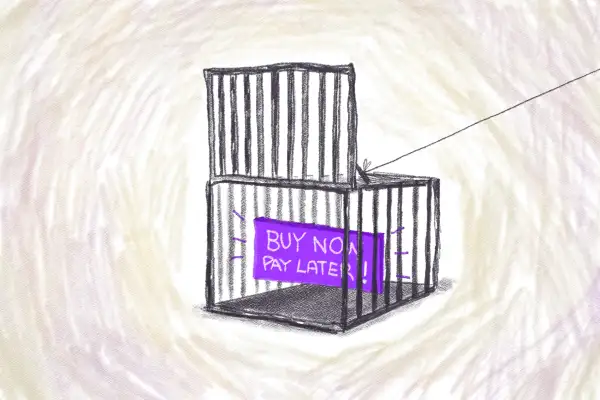Buy Now, Pain Later? Study Finds Installment Programs Hurt the Average Shopper

Anyone who has shopped online in the past few years has encountered one of the many short-term financing options known as buy now, pay later at checkout. And though they may sound enticing, hidden risks uncovered by researchers suggest that buy now, pain later might be a more apt label.
According to a study recently highlighted by the Stanford Graduate School of Business, use of BNPL programs can result in negative financial consequences for the average user, with effects ranging from overdraft charges to interest incurred on credit card balances.
The team behind the paper analyzed the bank and credit card histories of 10.6 million Americans between 2015 and 2021 and examined changes in people's financial well-being after making a purchase with BNPL. It also compared the data of more than 570,000 pairs of BNPL borrowers and similar non-borrowers.
What is buy now, pay later?
Buy now, pay later is pretty much what it sounds like. When a customer goes to check out an online order, they're typically presented with a few payment options. By selecting BNPL, fintech companies with catchy names like Zip and Sezzle pay the merchant upfront instead of the shopper.
The user generally makes a 25% down payment, gets their order and pays back an interest-free loan in four installments on a specific timeline (though terms vary by BNPL provider).
BNPL loans typically only cover smaller purchases, with the average BNPL loan hovering around $130, according to Experian. Most companies will lend amounts from $50 to $1,000 dollars for products like clothing, beauty products, groceries and even gas.
Since it took off, BNPL has become popular with consumers, especially younger shoppers and those with little or poor credit. A 2022 report by the Consumer Financial Protection Bureau found that among five BNPL providers analyzed, loan originations increased almost tenfold from 2019 to 2021, totaling over $24 billion. Today, some retailers, like Sephora and IKEA, even offer BNPL in stores.
Unlike traditional lenders, BNPL companies only run soft inquiries on borrowers to determine eligibility, making it easy to qualify, and the firms don’t have to report their data to credit bureaus. But this form of borrowing also has some downsides.
How BNPL impacts its users
The team of researchers, led by Stanford Graduate School of Business professor Ed DeHaan, found that while BNPL is a hit with consumers, it can also hit back.
“The financial savviness of the average user is not great,” DeHann said in a recent blog post about the study. “And we have plenty of evidence from history that, left to their own devices, the companies that issue credit tend to do so at consumers’ expense when they can.”
In their analysis, the researchers found that 13% of Americans tapped into BNPL between 2015 and 2021. And by 2021, the average borrower was paying $500 a quarter across a dozen BNPL installment payments.
The researchers then assessed the financial health of BNPL users by comparing their data to that of non-BNPL users with similar characteristics, using occurrences of overdraft charges, credit card interest payments and late fees as measurements. BNPL users incurred 4% more overdraft charges, 2.3% more credit card late fees, and their credit card interest was 1.1% higher than their non-BNPL counterparts.
The team also found that being offered BNPL by a retailer was a powerful predictor of whether a shopper would use the payment option. These users showed an 8.9% increase in overdraft charges, a 2.5% increase in credit card interest and an 8.4% jump in late fees over the six years analyzed.
All said, that adds up to $176 a year in extra charges for the average BNPL user. People who were particularly vulnerable, like those who wouldn't qualify for other forms of credit, paid up to $252 a year in extra fees on average.
Protecting consumers from BNPL misuse
A separate report from October 2023 indicates that people might not know exactly what they're getting into when taking advantage of BNPL programs.
That analysis, from the Consumer Federation of American and Center for Responsible Lending, discovered that respondents had a low level of understanding about how BNPL functions. Those with lower incomes were more likely to report using the payment alternative for purchases that they couldn’t afford without it.
While watchdog entities like the CFPB have raised flags about the potential harms of BNPL to U.S. consumers, this sector still has little oversight. Some states enforce rules — California requires BNPL providers to take out state lending licenses and follow state lending laws — but there's no federal regulation.
Otherwise, the BNPL industry essentially operates on a kind of honor system, with some companies claiming to follow an code of conduct co-created by BNPL providers, the Monetary Authority of Singapore and the Singapore FinTech Association.
The researchers say that BNPL isn’t an inherently bad payment choice, and given its rapid adoption and widespread use, it’s probably here to stay. DeHann said in the blog post that, as with any financial product, oversight is crucial to protect consumers and ensure that companies are accountable for their lending practices.
He went on to explain that making credit reporting mandatory for BNPL consumers would not only increase transparency but also prevent “debt stacking,” which occurs when consumers open multiple credit accounts at once and ultimately can’t manage their debt. Reporting would also reward BNPL users who pay their installments on time.
Given that BNPL is a popular option among consumers with limited credit, showing a positive BNPL payment history could help these users build their scores and qualify for other loans in the future.
Beyond that, DeHaan said, fraud protection, standard disclosures and a regulated dispute resolution process are also necessary to hold BNPL providers to the same standards as banks and other financial institutions — hopefully keeping consumers safe in the process.
More from Money:
Young People’s Wealth Is Growing Much Faster Than Older Generations


